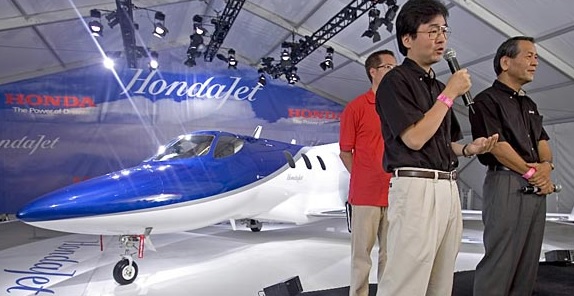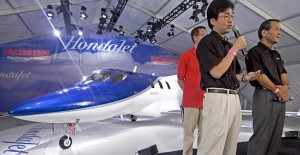
HondaJet : Wing Engine Mount breakthrough

HondaJet, achieved a breakthrough in aeronautics, the Over-The-Wing Engine Mount, was engineered and proven its innovative technology which breaks the conventional mould set by Aerospace industry, after more than 20 years of extensive research and development. This also give more spacious cabin, noise reduction, and increased fuel efficiency. The HondaJet’s engines are attached to the wings.
In September last year, potential customers and pilots were given a chance to take the HondaJet for a test spin, and Honda is confident they will appreciate the differences between its plane and conventional business jets. Michimasa Fujino, president and CEO of Honda Aircraft, the U.S. subsidiary in charge of developing and manufacturing the aircraft, has likened the jet to a luxury sports car. Also conveying a sense of luxury, he said, are its minimal vibration and noise during start-up. While most business jets have engines on the rear part of the fuselage, the two engines used for the HondaJet are mounted on the main wing. The company says the proprietary design not only results in a much more spacious cabin, it also enhances fuel efficiency and empowers a higher maximum spee. Mounting an engine on the main wing was long considered a big no-no for business jets. The argument was it would create too much aerodynamic drag between the nacelle, which covers the engine, and the main wing.
For HondaJet development project, mounting an engine on the main wing was not easy, as they have to consider steering stability, vibration characteristics and drag. After tinkering with a huge number of variables, Honda discovered the engine’s the wings are the place where aerodynamic drag was held to a minimum, as the jet uses a natural laminar flow wing, which aids a high lift coefficient, excellent stall characteristics, low drag while gaining altitude or cruising. The use of carbon fiber-reinforced plastic to reduce weight.
The HondaJet’s production plant is in Greensboro, North Carolina. In the “crossdraft” booth, air for ventilation flows horizontally, from the front to the rear of the aircraft. In the “downdraft” booth, air flows vertically, from the top to the bottom of the aircraft. The crossdraft booth is for the primer coat and the downdraft booth is for the top coat. The setup is aimed at achieving maximum quality and efficiency. The HondaJet is now undergoing final checks by the U.S. Federal Aviation Administration before its delivery to customers later this year. FAA pilots are conducting final test flights using four test planes.
